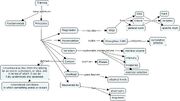Media[]
Links[]
- http://trainright.com/busting-myth-winter-aerobic-base-training/?utm_source=Content+Email+December+26+2016+-+Base+Training&utm_campaign=BaseTrainingMythDec26-16&utm_medium=email
- Train smarter, article, https://www.swimmingworldmagazine.com/news/using-neuroscience-to-train-smarter-not-harder/?fbclid=IwAR3nlhl_UerAMYzPwnFcx2qEvEZNgseRi6HRdZyd8fkCCHVQ01JGMtSfxoc
- Zwift Workouts - https://www.360velo.com/zwift-workouts/
- Broken
- http://www.courierpostonline.com/article/20111112/NEWS01/311120011/Body-balks-intense-training Intensity of training from November 2011
Map[]

Insights[]
Fundamental principles to achieve optimum adaptation to training.
Principle of Progression[]
The principle of progression moves from: simple to complex; easy to hard; and general-work to specific-work. Simple steps give way to complex interactions.
Progression is not linear. Think of progression as fitting pieces together. Constant progress should be made toward the goal, but some of the incremental steps along the way are smaller than others. Progression toward that ultimate objective proceeds in a staircase like progression. A clear picture of what the athletes achieve and looks like at the end of a training program is the end goal.
To insure progression, clearly define each step. Articulate specific goals and objectives for each step. Develop evaluative criteria to assess the achievement of each of the goals and objectives of each step. At certain levels of development, it is necessary to show mastery before moving on to the next step. This is especially true in refinement of technical development. Furthermore, all training variables do not progress at the same rate nor do all individuals progress at the same rate.
Principle of Accumulation[]
Adaptation to the stress of training is a cumulative process. The effect of training accumulates over time, provided training has been consistent and the athlete has been able to stay injury free. Adaptation to different training demands occurs at different rates and the ultimate training adaptation is the synergistic accumulation of the collective training responses.
Be patient, wait for training to take effect. The results of significant investments in training can be realized up to a year after the initial training stimulus. The gain from one workout seldom provides an immediate, positive, training response, except with small technical adjustments. One workout cannot make an athlete, but one workout can break an athlete.
Principle of Variation[]
Constantly manipulate the variables in a systematic manner: training volume, intensity, frequency and exercise selection. The body adapts to training stress quickly. Vary training to insure continued adaptation. Variation should not be random, but systematically planned to measure the effect of the variation. If training is not varied, then the body adapts quite quickly, and then the training effect is dull. If no variation is incorporated, then there is a significant risks with both staleness and over-training.
Principle of Context[]
The components of training need to fit into an overall context with understanding of what has already been done in the past and what is planned for the future. Well designed programs can put an emphasis on a component for a phase, but that fitness component should be kept in proportion to the other components and reside within the context of the whole training plan.
Incorporate training elements that fit into the context. An example violation of the principle of context happens when one component (i.e. speed or power) is trained to the exclusion of all the others. That would be fundamentally unsound.
Principle of Overload[]
Athletes progress when subjected to loads beyond they're adapted levels.
Overload is achieved through manipulation of the training variables of:
- volume, the amount of work;
- intensity, the quality of the work; and
- frequency of the training stimulus.
At the start of the athletic development process, volume loading results in rapid and sometime spectacular gains. It is easier to quantify training in terms of volume, (i.e., more runs, more jumps or more throws).
A reciprocal relationship exists between volume and intensity. Be careful about increasing both volume and intensity at the same time. Avoid the trap of overload through volume. One cannot keep adding volume without quickly reaching the point of diminishing returns. Volume is not a biomotor quality. As training age advances that paradigm must shift, and the overload must come more from intensity.
Principle of Recoverability[]
The ability to recover both short-term and long-term from a workload is crucial to positive adaptation to the training stimulus.
Appropriate loads for athletes dictate their ability to recover from training stresses. Different athletes have different abilities to recover. No two athletes are the same in ability, nor are they the same in the ability to recover. The principle of recoverability, of all the training principles, is easy to overlook. Do not get caught up in the work and ignore the ability to recover.
Details[]
Base training[]
In cycling, base training, in the winter season is around and base training has long been the refuge for athletes who just want to ride their bikes. Base training is largely unstructured, low-intensity cruising. In an effort to escape structure after a season of interval training, athletes fall back to the comfortable and antiquated idea of base training. There’s a difference, however, between desiring less structure and needing less workload. If you want a break from intervals, that’s fine. Let your mood, the terrain, the wind, or the group you’re with dictate the intensity; just make sure there’s some intensity!
